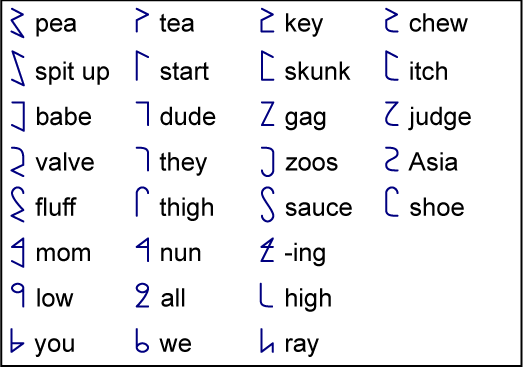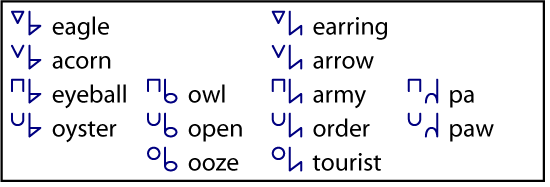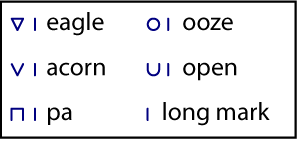
English is well on its way to becoming the long-sought World Language, but we should fix its orthography sooner rather than later. This page describes a proposed solution that, in relation to the current English alphabet
Universal Languages •Spelling Reform •A New Alphabet •Irregularity •Modifiers •Pronouns •A Sample •Feedback
| Universal Languages | top |
Back in 1879, a Roman Catholic priest in Baden by the name of Johann Martin Schleyer published a description of his planned universal language, Volapük, whose name means "World Speech". A few years later, in 1887, Ludwig Zamenhof of Königsberg published Esperanto, and subsequent efforts to promote a planned language as a solution to international communication have been legion, including Latino Sine Flexione, Novial, Interglossa, and Interlingua, to name only a few of the hundreds. Needless to note, none of them have been successful at attracting a following the size of even a minor language. See here for more on planned languages.
And yet several times in history, a language has come to be shared across a vast range of people as a first or second language, a pidgin or creole, or in written or liturgical form; to persist over a long span of time; and in fact to define a cultural area. Such was the case with Classical Greek in the ancient Mediterranean, Koine (the Greek dialect which was the common language of the Roman Empire), Latin in Western Christendom, Classical Arabic in the Islamic Umma, Sanskrit in the Hindu world, and Classical "Mandarin" Chinese in the imperial era.
We are now again in such an era, this time worldwide, with the emergence of English in the wake of the dominance of first England and then America since the industrial revolution (or the defeat of Napoleon, if you prefer) and the impact of recent technologies, especially the electrical and digital revolutions. English nows counts about 400 million native speakers and about an equal amount of non-native speakers, and is an official language of 60 countries. Except for perhaps Chinese, no other language can rival English's scope and depth.
While Chinese has about 1 billion native speakers (about 70% of China) and as many non-native speakers as English (half outside China), its geographical distribution is limited and the written corpus is tiny compared to many other languages. Chinese orthography, while fine for fluent readers, is very difficult for keyboards and learners, and its non-phonetic nature promotes a divergence between spoken and written forms that has been a historical problem for Chinese. Were Chinese to adopt a phonetic orthography like Hangul for Korean, and were China to develop economically, politically, and socially to the point of exporting culture, Chinese might become a more global language. Neither seems likely in this century.
However, the candidature of English for status as World Language has two big weaknesses: the first is its haphazard orthography, and the second is its lack of neutrality. My proposal is to address both issues at once: a serious orthographic reform would make English much more accessible to new learners and occasional users, at a huge cost to current literate speakers, including the cost of transcribing the written corpus. But this very cost enables us English speakers to meet the rest of the world halfway on the road to a common language, sharing the burden equitably.
The following describes a proposal along those lines, one which involves writing English with a new alphabet. But before accepting such an extreme solution, we should explore whether it wouldn't be easier just to fix our spelling using the Latin-based alphabet we now use.
| Spelling Reform | top |
Spelling reform in English has as long and sad a history as that of planned interlanguages, with Noah Webster's reforms of the early 19th century (musick to music, centre to center, plough to plow, colour to color, etc.) the only high note. In 1906, US President Theodore Roosevelt instructed the Government Printing Office to use the Simplified Spelling Board's spelling for about 300 words (e.g tho, thru) but Congress ended up opposing him. See here for more on spelling reform.
The basic problem of spelling in English is that the English alphabet added only six letters (J K V W Y & Z) to the 20-letter Latin alphabet, while English has at least 40 sounds (varying slightly by dialect). Traditionally, we remedy this by using digraphs like CH & NG, but not consistently, especially for vowels. One approach to reform is to regularize the use of digraphs. My favorite implementation of this is Weird-Looking Minglish.
Another approach would add about 20 new letters ("neographs") to the existing alphabet to enable a one-to-one correspondance between sounds and letters, perhaps by borrowing from other Latin-based alphabets, e.g. þ & ð from Icelandic (and Old English). This approach was taken with projects like Unifon and Readspel and in fact with many adaptations of the Latin, Cyrillic, and Arabic alphabets to new languages.
The use of digraphs to represent English vowels has some advantages. The long vowels can all be interpreted as diphthongs (which are best represented by digraphs), and using two letters to represent a longer sound isn't terrible. The problem is still 5 letters for 8 short vowels, so a mixed digraph/neograph notation for vowels might be the best approach.
Some systems have taken advantage of the variant glyphs of several vowels to indicate different sounds. In other words, they "split" one vowel so that, for example, the a with the "hood" represents a different sound from the a without. This is the approach used by the International Phonetic Alphabet (IPA), which has the advantage that current readers can sometimes read right past the change.
Here are some examples of attempted spelling reforms:
Wuns upon a midnít dréry,
wíl í ponderd wék and wéry
Over meny a kwaynt and kyuriyhs
vahlyum ev forgahtn lor,
W'iyl 'I nadid,
nirli na.ping, sa'dnli xer ke'm a' ta.ping
as av
sM wN jentlE raping, raping at mI kAmbR dor
"'Tiz sœm vizit'r", ai mœt'rd,
"tæping æt mai cémb'r dor - ónlí dhis ænd nœthing mor."
Here is my own best effort at a reformed Latin-alphabet orthography for English, one that keeps as many spellings familiar as possible. If you have trouble reading the following, you can consult the charts in the next section.
|
|
|
|---|
It shoud bee clir too yoo dhat, wutevur dher relutiv merits, aul dheez speling ruformz rukweiur us too lurn aour ritn langgwij aul oavur ugen. Uv kors u noo alfubet rukweiurz dhu saim hyooj efurt, but dhats dhu point: if wee kant kum up with u satisfaktoree ruform yoozing smal chainjez, wee mait az wel doo it rait and start oavur with u noo alfubet.
| A New Alphabet | top |
A World Alphabet offers several other advantages: its use would enable you to read foreign languages and foreign names, not perfectly but well enough to be understood - no more Americans wandering around Paris looking for "Noater Daym" - and it offers the same advantages to French visitors to the USA, or Brits in Spain, or Japanese in China, or whatever. It would also be a headstart to learning another language, and it would enable wide synergies of text entry and output, for example common keyboards.
The new alphabet is called the Shwa Alphabet - it's named after an artificial language called Shwa, for which it was first designed. The Shwa Alphabet for English is a subset of the full Shwa alphabet, which has letters for sounds we don't have in English, and it includes rules for combining letters into characters or words, for example for Chinese or Arabic, that we don't need for English. You can find more information about Shwa at www.shwa.org, but we're not going to talk about it any more on this page.
Like the old alphabet, the new one is written from left to right in lines which are then stacked in columns. In general, the letters are twice as high as they are wide. A space is used between words, but it has a dot at mid-height, and the other punctuation is different, too, including numerals. There is no upper- versus lower-case.
Here it is, with common English words as letter names:



In the following cases, the second letter of a long vowel can be abbreviated as a short vertical line:

Here are some quotations written in the Shwa alphabet:


| Irregularity | top |
In addition to orthography, there are some other small flaws in English that should be addressed at the same time. The first is the small number of remaining irregular forms for past tenses, past participles, and plurals. These can simply be replaced with the regular forms:
| Irregular | Regular | Irregular | Regular | Irregular | Regular |
|---|---|---|---|---|---|
| ate | eated | flew | flyed | read | readed |
| began | beginned | found | finded | rode | rided |
| bought | buyed | gave | gived | said | sayed |
| brought | bringed | got | getted | saw | seed |
| built | builded | had | haved | spoke | speaked |
| came | comed | heard | heared | stood | standed |
| caught | catched | knew | knowed | taught | teached |
| chose | choosed | left | leaved | told | telled |
| did | doed | let | letted | took | taked |
| drank | drinked | made | maked | went | goed |
| fell | falled | ran | runned | wrote | writed |
| Irregular | Regular |
|---|---|
| to be | to are |
| I am | I are |
| you are | you are |
| he is | he are |
| I was | I ared |
| you were | you ared |
| he was being | he ared aring |
| he had been | he haved ared |
| Irregular | Regular |
|---|---|
| he gives | he give |
| she sees | she see |
| it goes | it go |
| Irregular | Regular |
|---|---|
| children | childs |
| feet | foots |
| fish | fishes |
| geese | gooses |
| men | mans |
| mice | mouses |
| people | persons |
| sheep | sheeps |
| teeth | tooths |
| wolves | wolfs |
| women | womans |
| Modifiers | top |
In "correct" English, we can only modify a noun with an adjective (or a possessive pronoun or noun, which is a kind of adjective). There is no grammatical mechanism for concatenating two nouns to show that the first modifies the second.
But in fact, that's what we do all the time: we say telephone pole and cat food, not telephonic pole and feline food, and this causes no problems at all. Even the stodgy New York Times doesn't call itself the New Yorker Times.
So let's add this mechanism to our grammar rules (not grammatical rules) and stop making silly adjectives like Washingtonian or sylvan. We can call a place that repairs cars a car repair shop, as opposed to automotive repair shop, and we can call a nice meal a cooking masterpiece instead of a culinary masterpiece.
Based on that principle, there is no need to add -'s to the possessive; position alone indicates the case:
| Irregular | Regular |
|---|---|
| the street's name | the street name |
| a cat's paw | a cat paw |
| world's champion | world champion |
| two weeks' notice | two weeks notice |
| John's book | John book |
| my book | me book |
| Pronouns | top |
The final flaw is our personal pronoun system. Many languages (e.g. French, Spanish) have grammatical gender, and numerous languages (e.g. German, Russian) also have grammatical case: words have different forms depending on their role in a clause. English is free of both complications, and no worse off for it, but we retain the vestiges of our former gender and case systems in our pronouns: he/his/him, she/hers/her, it/its/it. Many languages also distinguish polite and familiar forms in the second person, thou versus you, but English doesn't even distinguish plural you, unless you say youse or you all.
The most radical change I'm proposing is to revisit our personal pronoun system, with the following goals:
The result is as follows:
| Person | Singular | Plural | ||
|---|---|---|---|---|
| English | Regular | English | Regular | |
| First not Second | I/my/me | my | we/our/us | mys |
| First and Second | we/our/us | we | we/our/us | wes |
| Second not First | you/your/you | you | you/your/you | yous |
| Neither First nor Second | he/his/him she/hers/her it | they | they/their/them | theys |
Singular we is used when both my and you are singular: just you and me. The disjunctive forms (mine, yours , etc.) would be replaced by of my, of you, etc. The word it would still be used when the clause requires a pronoun that refers to nothing, e.g. it are hot.
| Grammar | top |
In English, conjunctions and prepositions are often the same. We can say before your visit (preposition) or before you visited (conjunction), with little difference. The same is true of after, because (of), until, since and so on.
Strict grammarians are famous for correcting John and me went home or He is taller than me, insisting that we use I instead of me in both cases. But me is correct: in those cases, and and than are functioning as prepositions, not conjunctions, and the pronouns belong in the objective case. You can say John is taller than I am - now it's a conjunction - but not John is taller than I.
They also want us to say It's I. But It's me is correct, as we all recognize: in English, the object of a copular verb is in the accusative, not the nominative.
| A Sample | top |
Here is a sample paragraph incorporating these proposed changes:
| Feedback | top |
Please send me your comments, suggestions, corrections, questions, testimonials and invective. If I feel they're of interest to my audience, I'll post them here (without identifying you). I reserve the right to edit your contributions for length, language, and clarity.
I cdnuolt blveiee taht I cluod aulaclty uesdnatnrd waht I was rdanieg! The phaonmneal pweor of the hmuan mnid. Aoccdrnig to a rscheearch taem at Cmabrigde Uinervtisy, it deosn't mttaer in waht oredr the ltteers in a wrod are, the olny iprmoatnt tihng is taht the frist and lsat ltteer be in the rghit pclae. The rset can be a taotl mses and you can sitll raed it wouthit a porbelm. Tihs is bcuseae the huamn mnid deos not raed ervey lteter by istlef, but the wrod as a wlohe. Such a cdonition is arppoiately cllaed Typoglycemia :)- Amzanig huh? Yaeh and yuo awlyas thought slpeling was ipmorantt.
| home | top |
| © 2002-2019 Alivox | www@alivox.net | 04feb19 |